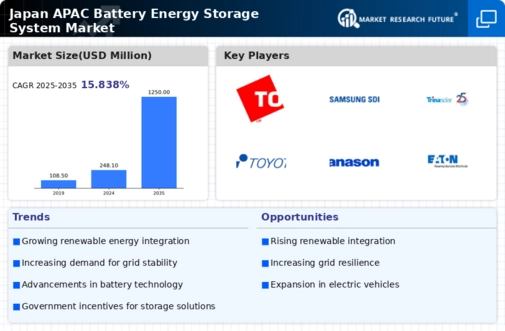The Japan APAC Battery Energy Storage System Market has become increasingly competitive in recent years due to a surge in demand for renewable energy solutions and the integration of advanced technologies. With the government focusing on energy security and promoting policies aimed at reducing carbon emissions, numerous companies have entered the market to capitalize on these trends. The competition is primarily driven by innovations in battery technologies, cost reduction strategies, and the need for enhanced energy efficiency.
As part of this dynamic landscape, several key players have emerged, harnessing their technological expertise and market presence to secure a foothold in the renewable energy sector in Japan.
The competition not only fuels advancements in battery design and applications but also enhances the overall quality and viability of energy storage systems in the region.Toshiba has established itself as a significant player in the Japan APAC Battery Energy Storage System Market by leveraging its extensive experience in electrical engineering and energy solutions. The company is recognized for its innovative battery technologies and high-performance energy storage solutions, which play a crucial role in supporting Japan's energy transition goals. Its strengths lie in the development of advanced lithium-ion batteries, optimizing energy storage to improve grid stability and reliability.
Additionally, Toshiba’s commitment to sustainability and the development of smart energy systems has helped it to reinforce its position in the market. The company has also engaged in strategic collaborations and partnerships that enhance its capabilities while focusing on the Japanese market, leading to a robust presence in the battery storage sector.Samsung SDI has emerged as a formidable force in the Japan APAC Battery Energy Storage System Market, positioning itself through its extensive portfolio of high-performance lithium-ion batteries and storage solutions.
The company is renowned for its continuous investment in research and development, which has resulted in the introduction of cutting-edge technologies that enhance battery efficiency and longevity.
Samsung SDI’s key products in the Japanese market include energy storage systems designed for industrial applications and renewable energy integration, catering to both commercial and residential customers. The company has strategically expanded its operations in Japan through mergers and acquisitions, allowing it to strengthen its local market presence and foster collaborations with regional energy firms. With its strong focus on innovation and sustainability, Samsung SDI is well-poised for growth in the competitive landscape of the Japan Battery Energy Storage System Market.
























Leave a Comment